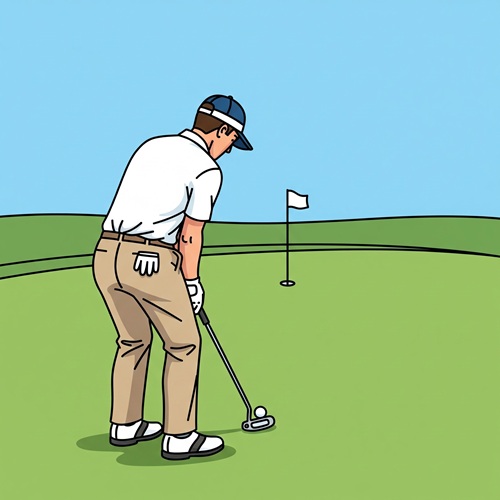Match Play vs Stroke Play
Golf offers two distinct ways to compete, each creating entirely different strategic approaches to the game.
These two forms of play have shaped golf’s greatest moments, from the Ryder Cup’s intense team events to the pressure-packed final rounds of major championships like The Masters.

Whether you’re watching professional tournaments or planning your next round with friends, understanding match play vs stroke play will transform how you think about golf and its challenges.
What is Stroke Play?
Stroke play, also known as medal play, is golf’s most familiar scoring system, where every shot counts toward your total score.
You’ll find this format in most professional tournaments, including all four major championships, where golfers battle over four rounds.
In stroke play, the golfer with the lowest score after completing all holes wins the competition. Every stroke matters, whether you’re hitting your approach shot or facing a one stroke penalty for a rules violation.
The beauty of stroke play lies in its straightforward scoring system, as you simply count how many strokes it takes to complete each hole, add them up, and compare totals.
This scoring system rewards consistent play throughout the round, as one bad hole can significantly impact your final position.
Professional golfers in stroke play must maintain focus for the entire round since every shot directly affects their standing.
A single mistake on one hole can’t be erased by winning the next hole. It becomes part of your permanent total score.
What is Match Play in Golf?
Match play creates head-to-head competition where golfers battle on a hole by hole basis rather than counting total strokes.
In this match play format, you’re trying to win individual holes against your opponent, not achieve the lowest overall score.
Each particular hole becomes its own mini-competition. The golfer with fewer strokes wins that hole, while ties result in halved holes. The match ends when one player leads by more holes than remain to be played.
This match play competition transforms golf strategy completely, as your opponent’s performance directly influences your decisions.
You might play aggressively to match a great shot or play conservatively when your opponent struggles on a specific hole.
The match play format creates dramatic moments where a golfer can be several holes down but still mount a comeback.
Unlike stroke play, a terrible score on one hole only costs you that single hole, not multiple strokes in your total.
What is the Difference Between Match Play vs Stroke Play?
The fundamental difference between match play and stroke play lies in how victory is determined and in on-course strategy.
Stroke play focuses on your personal performance against the golf course, while match play pits you directly against an opponent.
Scoring and Strategy Differences
In stroke play, every shot contributes to your final total, making consistency the key to success.
A bad hole in stroke play can ruin an entire round, as those extra strokes permanently damage your total score against the field.
Match play scoring operates differently. You’re only trying to beat your opponent on each hole, not achieve perfection. This creates opportunities for more aggressive play since the worst you can do is lose that particular hole.
The strategic implications run deep, as match play allows you to adapt your approach based on your opponent’s performance.
If your opponent hits into trouble, you can play safely, or if they make a great shot, you might need to take a risk with your upcoming shot.
Tournament Format
The vast majority of professional tournaments use stroke play because it fairly determines the best overall performer across the entire field.
The number of strokes taken over four rounds provides a clear objective measure of skill and consistency.
Match play tournaments follow a different structure, typically featuring bracket-style elimination where winners advance hole by hole through multiple rounds.
The Ryder Cup showcases match play’s team format, where individual matches contribute to overall team victory.
Women’s golf features both formats, though stroke play dominates the professional tour schedule. Team events often incorporate match play elements to create more dramatic, head-to-head competition that engages spectators.
Why Should Amateurs Play Match Play?
Amateur golfers should embrace match play competition because it removes the pressure of perfect scoring while maintaining competitive intensity.
Instead of worrying about your total strokes, you focus on beating your opponent on more holes than they beat you.
Match play format encourages aggressive play and shot-making creativity that stroke play might discourage. When you’re down in a match, you can take risks knowing that a bad result only costs you one hole, not multiple strokes.
This scoring system also speeds up play, as holes end when one player has already won, eliminating the need to finish every hole.
Match play creates natural conversation and camaraderie between opponents, making it perfect for friendly competitions and regular golf outings.
Is the Masters stroke play or match play?
The Masters Tournament uses the stroke play format. All players complete four rounds at Augusta National, counting every shot toward their total score.
The golfer with the lowest cumulative score after 72 holes wins the coveted green jacket.
This differs from match play, where you compete hole-by-hole against individual opponents, similar to what you see at the Ryder Cup and other team events.
Is Stableford match play or stroke play?
Stableford is a stroke play scoring system, not match play. In Stableford, players earn points based on their score relative to par on each hole, with the total points determining the winner.
For example, a birdie is worth 3 points, while a bogey is only worth 1 point in Stableford.
Unlike match play, where holes are won individually, Stableford accumulates points across the entire round using a stroke play format, and the highest point total leads or wins the round.